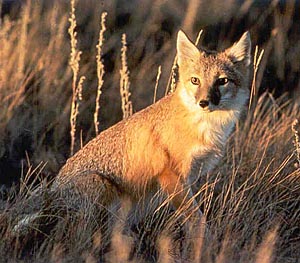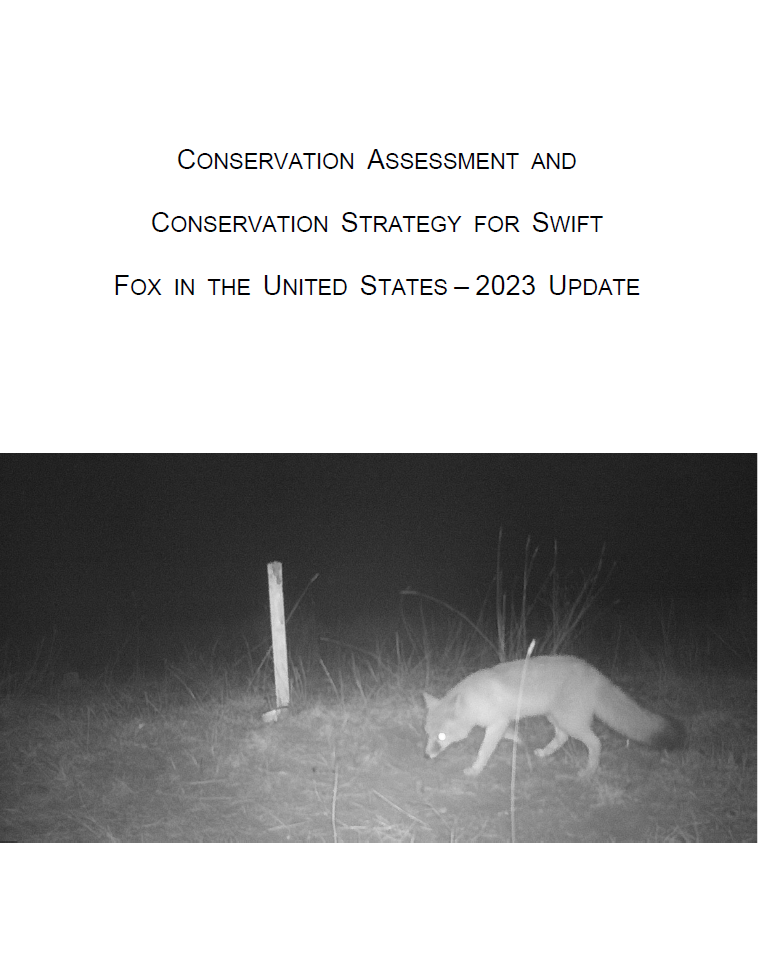Swift Fox

WESTERN GRASSLAND SPECIES:
Swift Fox (Vulpes velox)
Photo by Colorado Parks & Wildlife
Conservation Assessment and Conservation Strategy for Swift Fox in the United States – 2023 Update
This year marks the 30th year of the existence of the Swift Fox Conservation Team (SFCT). This Team was convened in 1994 by the ten affected state wildlife management agencies and interested cooperators after the USFWS had concluded that listing was warranted throughout the entire range for this species. The SFCT sits under the Grassland Initiative in WAFWA one of the first assignments was to develop a coordinated conservation effort which would be detailed in a conservation plan.
The SFCT completed a Conservation Assessment and Conservation Strategy for Swift Fox in the United States (CACS) in 1997. This document represented a coordinated approach to range-wide conservation and management. As a result of new information, and improved coordination among partners, the USFWS removed the swift fox from the candidate species list in 2001 (Dowd Stukel 2011).
In 2011, an updated CACS was published identifying eight objectives for securing swift fox conservation (Dowd Stukel 2011). A change to the format of the 2011 document from the previous version consisted of providing accomplishments and a conservation assessment based directly on the five factors the USFWS uses to evaluate species for listing or delisting under the ESA. A major conclusion of that document was the SFCT’s assessment that none of the five listing factors had risen to the level of a threat.
This is the third version of CACS. In assessing the objectives identified in the previous CACS, we believe these objectives are currently being met, though some underlying strategies and activities remain incomplete. Like the previous CACS, we provide a conservation assessment organized by listing factor, and again conclude none of these factors currently rise to the level of a threat. Though questions about the status of swift foxes in portions of the range exist, we do note the apparent range expansion documented in this publication. We also note the significant amount of research conducted and knowledge gained about swift foxes since the inception of the SFCT.
Background
The swift fox (Vulpes velox) is native to the shortgrass and mixed-grass prairies of the Great Plains in the central United States, although the species has demonstrated adaptability to other habitat types. Settlement, unlimited fur harvesting, and indiscriminate pesticide use for predator control reduced the species’ range from the late 1800s to the early 1900s. The swift fox recovered in portions of its historical range, although populations in the northern portion of the range did not recover at the same rate by the late 1980s.
In 1992, the U.S. Fish and Wildlife Service (Service) received a petition to list the swift fox under the authority of the Endangered Species Act in the northern portion of the species’ range (Montana, North Dakota, South Dakota, and Nebraska), if not the entire range. In 1994, the Service concluded that listing was warranted in the entire range. Also in 1994, the ten affected state wildlife management agencies and interested cooperators formed the Swift Fox Conservation Team (SFCT).
The SFCT completed the Conservation Assessment and Conservation Strategy for Swift Fox in the United States (CACS) in 1997 to guide management and conservation activities. The Service’s 12-month finding in 1995 designated the swift fox as a federal candidate species, with listing warranted but precluded by higher listing priorities. The CACS has guided activities of state, federal, tribal, and private entities to provide defensible data on swift fox abundance and distribution with a more coordinated approach to range-wide conservation and management. As a result of new information and improved coordination among partners, the Service removed the swift fox from the candidate species list in 2001.
The commitment of state and federal agencies, tribes, private organizations, and landowners in the U.S. and Canada to swift fox restoration continued following removal of the species from the candidate species list. In 2011, the SFCT completed and update to the 1997 CACS. This document summarizes accomplishments associated with established strategies and objectives outlined in the CACS. Also included are summaries of 13 team reports, which include reports from 16 team meetings held from 1994-2010.
This update includes a conservation assessment, or risk assessment of the five listing factors to long-term swift fox sustainability and concludes that none of the listing factors has risen to the level of a threat. This update also includes a revised strategy section with associated objectives, strategies, and activities to provide a guidance framework for continued monitoring, research, and recovery. Revisions to the previous strategy section of the CACS reflect completion of a significant amount of work and reconsideration of remaining threats in light of current knowledge.
The overall goal of the conservation strategy is to maintain or restore swift fox populations within each state to provide the spatial, genetic, and demographic structure of the United States swift fox population to ensure long-term species viability, to provide species management flexibility, and to encourage population connectivity.
The eight primary objectives of the conservation strategy are:
- Maintain a swift fox conservation team.
- Maintain swift fox distribution in at least 50 percent of the suitable, available habitat.
- Evaluate the status of swift fox populations.
- Identify and conserve existing native short and mid-grass grasslands, focusing on those with habitat characteristics conducive to swift fox.
- Facilitate partnerships and cooperative efforts to protect, restore, and enhance suitable habitats within potential swift fox range.
- Identify and encourage research studies that contribute to swift fox conservation and management.
- Promote public support for swift fox conservation activities through education and information exchange.
- Maintain swift fox population viability such that listing under the U.S. Endangered Species Act is not justified.
